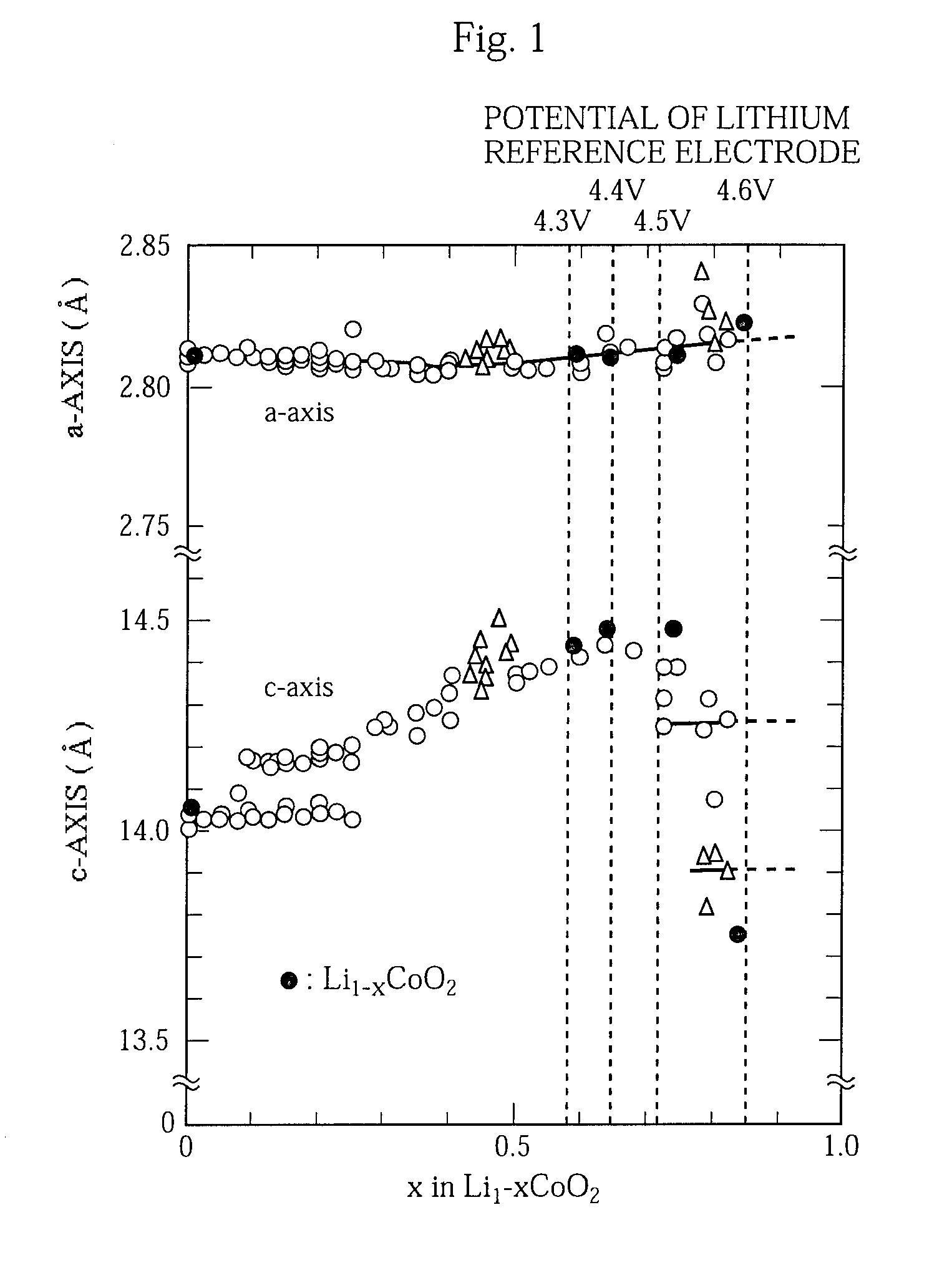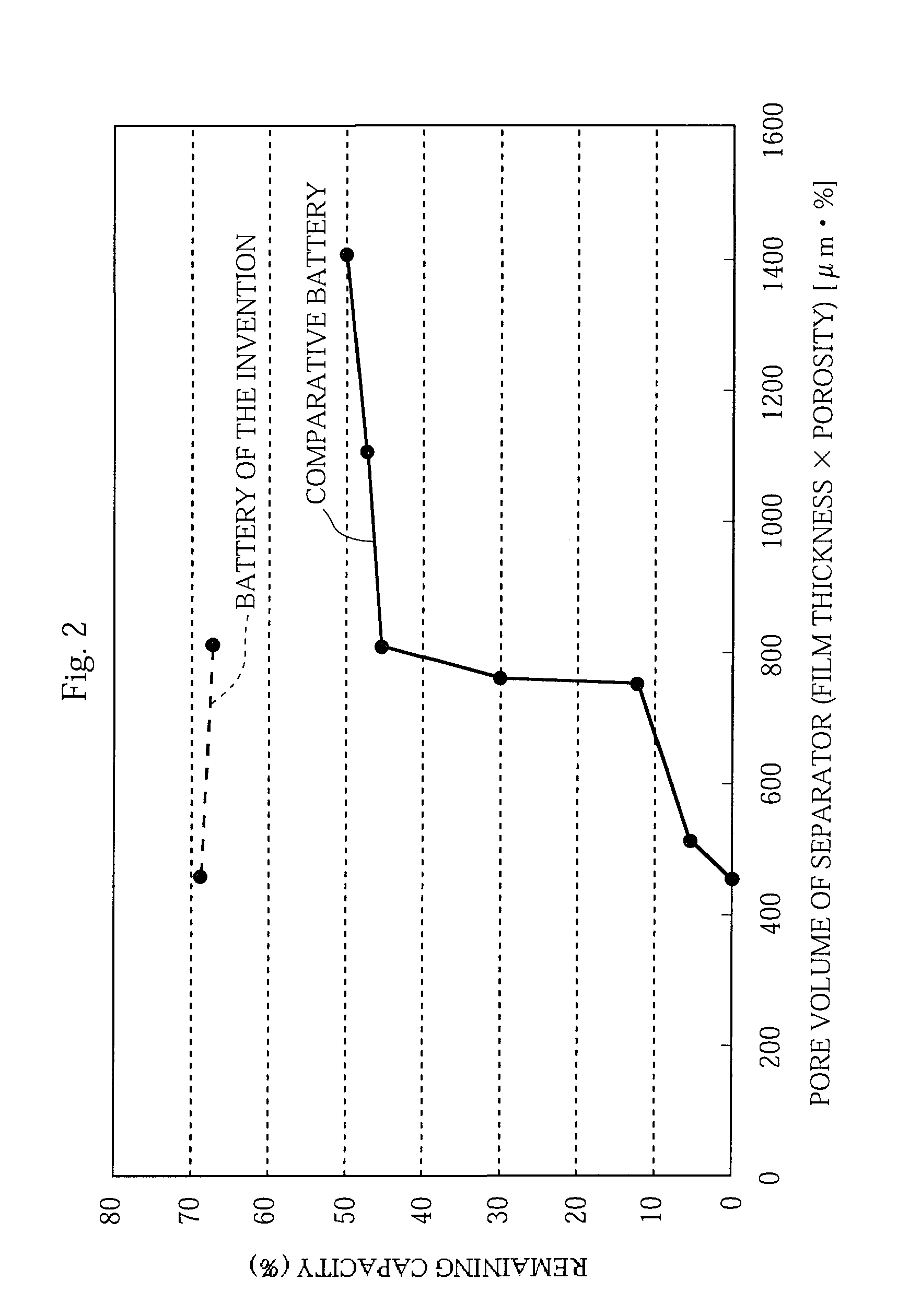Non-aqueous electrolyte battery and method of manufacturing the same
a non-aqueous electrolyte, battery technology, applied in the direction of batteries, sustainable manufacturing/processing, cell components, etc., can solve the problems of increasing the cost of electrolyte solution decomposition, etc., to achieve the effect of reducing the cost of electrolyte solution
- Summary
- Abstract
- Description
- Claims
- Application Information
AI Technical Summary
Benefits of technology
Problems solved by technology
Method used
Image
Examples
first embodiment
[Preparation of Positive Electrode]
[0094]First, lithium cobalt oxide (in which 1.0 mol. % of Al and 1.0 mol. % of Mg are contained in the form of solid solution and 0.05 mol. % of Zr is firmly adhered to the surface) as a positive electrode active material, acetylene black as a carbon conductive agent, and PVDF as a binder agent were mixed together at a mass ratio of 95:2.5:2.5. Thereafter, the mixture was agitated together with NMP as a solvent, using a Combimix mixer made by Tokushu Kika Kogyo Co., Ltd., to thus prepare a positive electrode mixture slurry. Next, the resultant positive electrode mixture slurry was applied onto both sides of a positive electrode current collector made of an aluminum foil, and the resultant material was then dried and calendered, whereby a positive electrode was prepared in which positive electrode active material layers were formed on both surfaces of the aluminum foil. The filling density of the positive electrode active material layer was controll...
second embodiment
[0100]A battery was fabricated in the same manner as in described in the first embodiment above, except that a non-aqueous electrolyte solution prepared in the following manner was used as the non-aqueous electrolyte solution and that a separator prepared in the following manner was used as the separator.
[Preparation of Non-Aqueous Electrolyte]
[0101]LiPF6 and LiBF4 were dissolved at a proportion of 1.0 mole / liter (M) and at a proportion of 1 mass %, respectively, in a mixed solvent of 3:7 volume ratio of ethylene carbonate (EC) and diethyl carbonate (DEC) to prepare a non-aqueous electrolyte.
[Type of Separator]
[0102]A polyethylene microporous film (film thickness: 16 μm, average pore size: 0.1 μm, porosity: 47%) was used as the separator.
embodiments
Preliminary Experiment 1
[0103]What type of binder and what type of dispersion process should be used to obtain good dispersion capability of the slurry were investigated by varying the type of binder and the method of dispersion processes used for preparing the coating layer of the separator. The results are shown in Table 1.
(Binders Used and Methods of Dispersion Process)
[1] Binders Used
[0104]Three types of binders were used, namely, PVDF (KF1100 made by Kureha Corp., one commonly used for a positive electrode for lithium-ion battery, hereinafter also abbreviated as PVDF for positive electrode), PVDF for gel polymer electrolyte (PVDF-HFP-PTFE copolymer, hereinafter also abbreviated as PVDF for gel polymer electrolyte), and elastic polymer containing an acrylonitrile unit.
[2] Methods of Dispersion Process
[0105]A dispersion process with a disperser (30 minutes at 3000 rpm), a dispersion process using a Filmics mixer made by Tokushu Kika Kogyo Co., Ltd. (30 seconds at 40 m / min.) and a...
PUM
| Property | Measurement | Unit |
|---|---|---|
| filling density | aaaaa | aaaaa |
| thickness | aaaaa | aaaaa |
| temperature | aaaaa | aaaaa |
Abstract
Description
Claims
Application Information
 Login to View More
Login to View More - R&D
- Intellectual Property
- Life Sciences
- Materials
- Tech Scout
- Unparalleled Data Quality
- Higher Quality Content
- 60% Fewer Hallucinations
Browse by: Latest US Patents, China's latest patents, Technical Efficacy Thesaurus, Application Domain, Technology Topic, Popular Technical Reports.
© 2025 PatSnap. All rights reserved.Legal|Privacy policy|Modern Slavery Act Transparency Statement|Sitemap|About US| Contact US: help@patsnap.com



